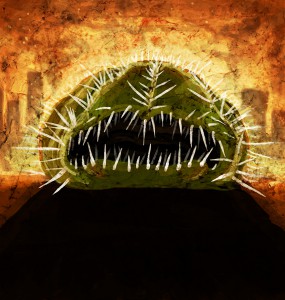A letter by Dr. Alan Dimplebottom, as provided by Jennifer Mitchell
Art by Leigh Legler
My dear residents of Earth City,
I feel obligated to write this letter in Earth City Daily News to clear up last month’s cactus situation. None of us in the scientific community could have predicted such enormous destruction to property and life, but the advances that have been made in our understanding of alien plant life are extraordinary. I feel that if the general public is made aware of these advances, it will be more understanding of the destruction.
Unbeknownst to most of you, unmanned space ships have been searching our galaxy for alien flora since 2273, and this year, on planet X32C31, the discovery was made. The cacti were so tiny that the scanners nearly missed them, but a few samples were brought back to Earth for study. One of them was personally delivered to me for dissection and analysis.
On X32C31, the atmosphere is composed mostly of nitrogen and cyanide. Temperatures hover far below freezing, and hurricane force winds rip across the planet’s surface. While cacti survive well in extreme desert conditions, this was far beyond anything on Earth, and we were curious to discover how the cacti were surviving. It seems that they were barely clinging to life on that planet, as the cacti thrived in Earth’s conditions, growing at an unbelievable speed.
When the cactus was first delivered to me, it was about the size of a pea, but within days it was the size of a watermelon. Absolutely extraordinary in itself, but then it began dividing. It was acting more like a virus than a plant, splitting over and over, filling my office to the roof with cacti. This is something that has never been seen before, so I let it continue for longer than was prudent, in the interest of scientific advancement.
The cacti continued to grow, from the size of watermelons to the size of small cars. None of my readers will be surprised by this, knowing what we now know, but my office was destroyed, and then the entire wing of the university, as they grew.
At this point I began to become concerned, and sent my assistant Geoffrey to purchase pesticides. This was a painful decision for me, as the chance to analyze alien cacti was a once in a lifetime opportunity, but at this point I was beginning to see the danger. Geoffrey returned from the hardware store with several canisters of pesticide spray, which we emptied on the cacti. This did not have the desired effect. Not only did the cacti not die, but they became carnivorous. Poor Geoffrey fought bravely, but he was no match for them. I am ashamed to admit it, but I ran.
Once I reached the safety of my apartment, I called my friend Dr. Agnes Snifflebop. She has a PhD in Botany, and was heavily involved with the mission to find alien flora. I knew that if anyone could help with this situation, it would be her. At first, she didn’t believe that the tiny cacti she had helped discover were dangerous. I told her to turn on the news, and the sight of the rubble that used to be the university was enough to convince her that we were in trouble.
Together, we set out to destroy the cacti. We were both heartbroken to destroy our lives’ work, but these are the sacrifices that must be made. In hindsight, I should have acted earlier, as soon as I saw the cacti multiplying. But it is too late for that now.
We tried various mixtures of extra strength pesticides, but the only effect was to make the cacti hungrier. Their growth continued at exponential rates. At this point, after being on Earth for less than one week, each cactus was the size of a football stadium. We pursued them with our pesticide guns as they rolled through the city, flattening buildings and consuming citizens, but to no avail.
To read the rest of this story, check out the Mad Scientist Journal: Spring 2014 collection.
Dr. Alan Dimplebottom is one of the most respected scientists in the world, with Ph.D.s in both astronomy and astrophysics. He has published over one thousand scientific papers, in respected journals such as The Space Journal and Earth’s Science Digest. Look for his new book, The Curious Case of the Cacti, which will be released sometime next year.
Jennifer Mitchell is a Canadian writer of science fiction, fantasy, and horror. Born in 1722, a homemade time machine has allowed her to write stories for the people of the future. She lives in a haunted house with a robot named Xyerhsl and a pet Bigfoot. She has been abducted by aliens twice. Do not approach Jennifer, because it may be her identical evil twin, NotJennifer, who is a wanted criminal in six galaxies.
Leigh’s professional title is “illustrator,” but that’s just a nice word for “monster-maker,” in this case. More information about them can be found at http://leighlegler.carbonmade.com/.
Follow us online:
